Finding the best time to post on Instagram can feel like trying to hit a moving target. While numerous studies point to generic 'peak hours,' the real key to maximizing your reach and engagement lies in a strategy that goes deeper than just picking a time slot from a chart. It’s about understanding the unique digital habits of your specific audience, the psychology behind their daily routines, and recognizing how different content formats perform at various times of the day. A perfectly crafted post shared at the wrong moment can easily get lost in the feed, diminishing its potential impact and wasting valuable resources.
This guide moves beyond the one-size-fits-all advice. We will break down eight specific, data-driven strategies you can implement immediately to pinpoint your optimal posting schedule. We'll explore how to leverage your own analytics for custom insights, align your content type with user behavior, and even find opportunities by posting when your competitors are offline. Whether you're targeting a local community or a global following, these actionable insights will help you stop guessing and start posting with strategic intent. You will learn to ensure your content lands in front of the right people at the exact moment they’re most likely to like, comment, and share.
1. Post During Peak Engagement Hours (Generally 11 AM – 1 PM)
Posting during peak engagement hours means scheduling your content when the largest segment of your audience is actively scrolling. While every account's audience is unique, broad industry studies consistently identify the midday window of 11 AM to 1 PM as a prime-time slot. This period aligns perfectly with lunch breaks and general work lulls, when users turn to their phones for a quick mental break and social connection.
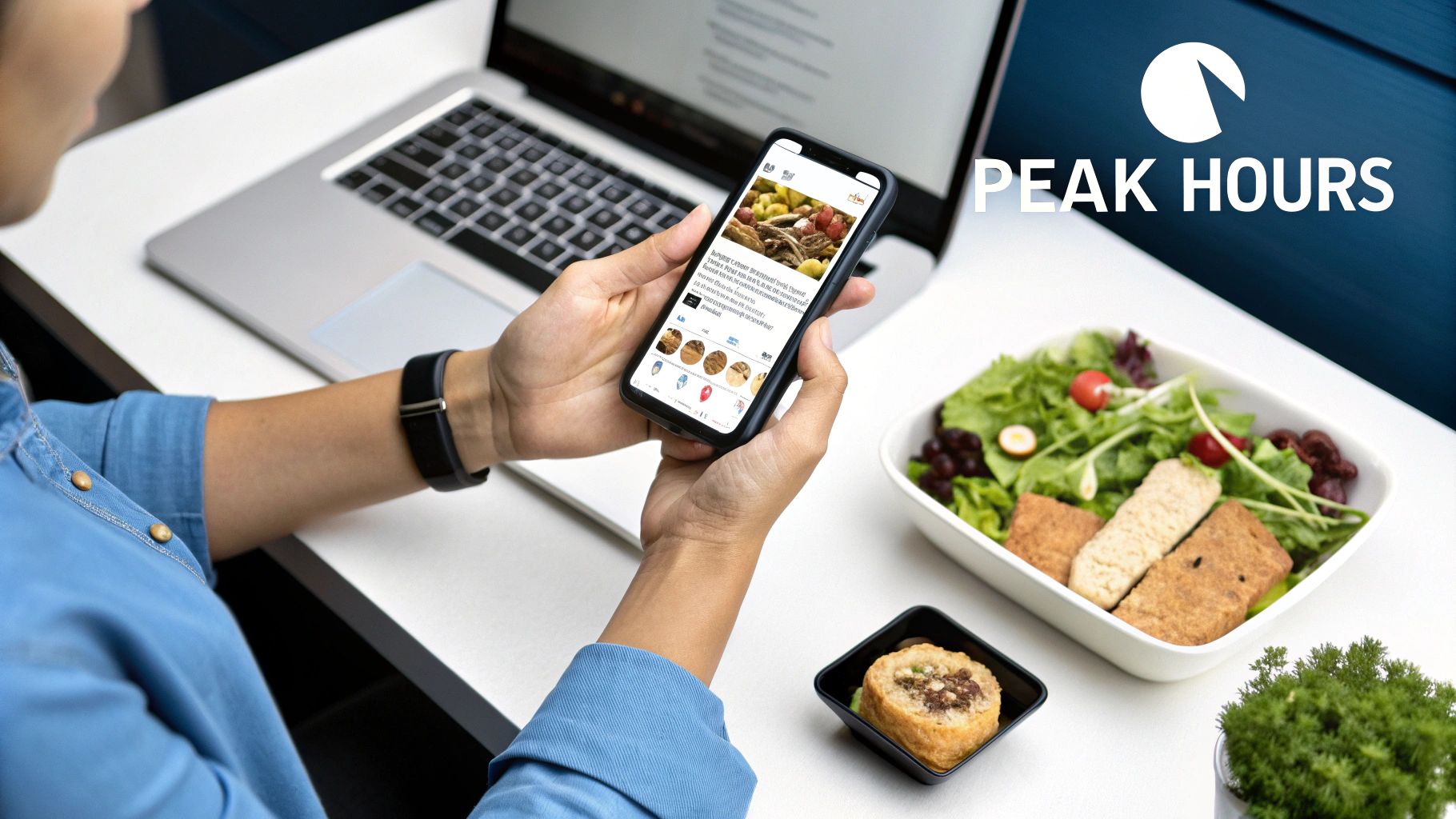
Targeting this window helps your post gain immediate traction. The Instagram algorithm often prioritizes content that receives rapid engagement, potentially boosting its visibility on user feeds and the Explore page. This is a fundamental strategy for determining the best time to post on Instagram for your brand.
How to Implement This Strategy
To effectively leverage this peak window, start by identifying your primary audience's time zone. If your followers are spread globally, focus on the time zone with the highest concentration of users.
- B2C Brands: A food blogger might share a vibrant recipe Reel at 11:45 AM, just as followers are thinking about lunch, capturing their attention with a timely and relevant post. This can lead to a significant spike in saves and shares.
- B2B Companies: A SaaS company could post an infographic with industry insights at 12:00 PM. This targets professionals browsing LinkedIn and other platforms during their lunch break, positioning the brand as a valuable resource.
- Fitness Influencers: A brand like Nike often shares workout motivation around noon, capitalizing on the midday energy slump and inspiring followers to plan an evening gym session.
Actionable Tips for Success
Fine-tuning your timing within this window is key to maximizing its potential.
- Test and Verify: Use Instagram Insights to check your "Most Active Times." Post at 11:00 AM, 12:00 PM, and 1:00 PM on different days to see which specific slot generates the best results for your audience.
- Post Pre-Peak: Schedule your content for 15-30 minutes before the absolute peak (e.g., 11:45 AM instead of 12:15 PM). This gives the algorithm time to index and distribute your post, allowing it to build momentum just as user activity surges.
- Consider Content Type: A quick, engaging Story might perform well at the beginning of the lunch hour (11:00 AM), while a more in-depth Carousel post could capture attention later (12:30 PM) when users have more time to swipe through.
2. Leverage Your Audience's Instagram Insights and Analytics
While general best practices provide a great starting point, the most effective strategy is to listen to your own audience. Using Instagram's native analytics tools allows you to move beyond broad recommendations and pinpoint the exact times your specific followers are most active. This data-driven approach is the ultimate key to determining the best time to post on Instagram because it’s tailored specifically to your community's unique behavior patterns.
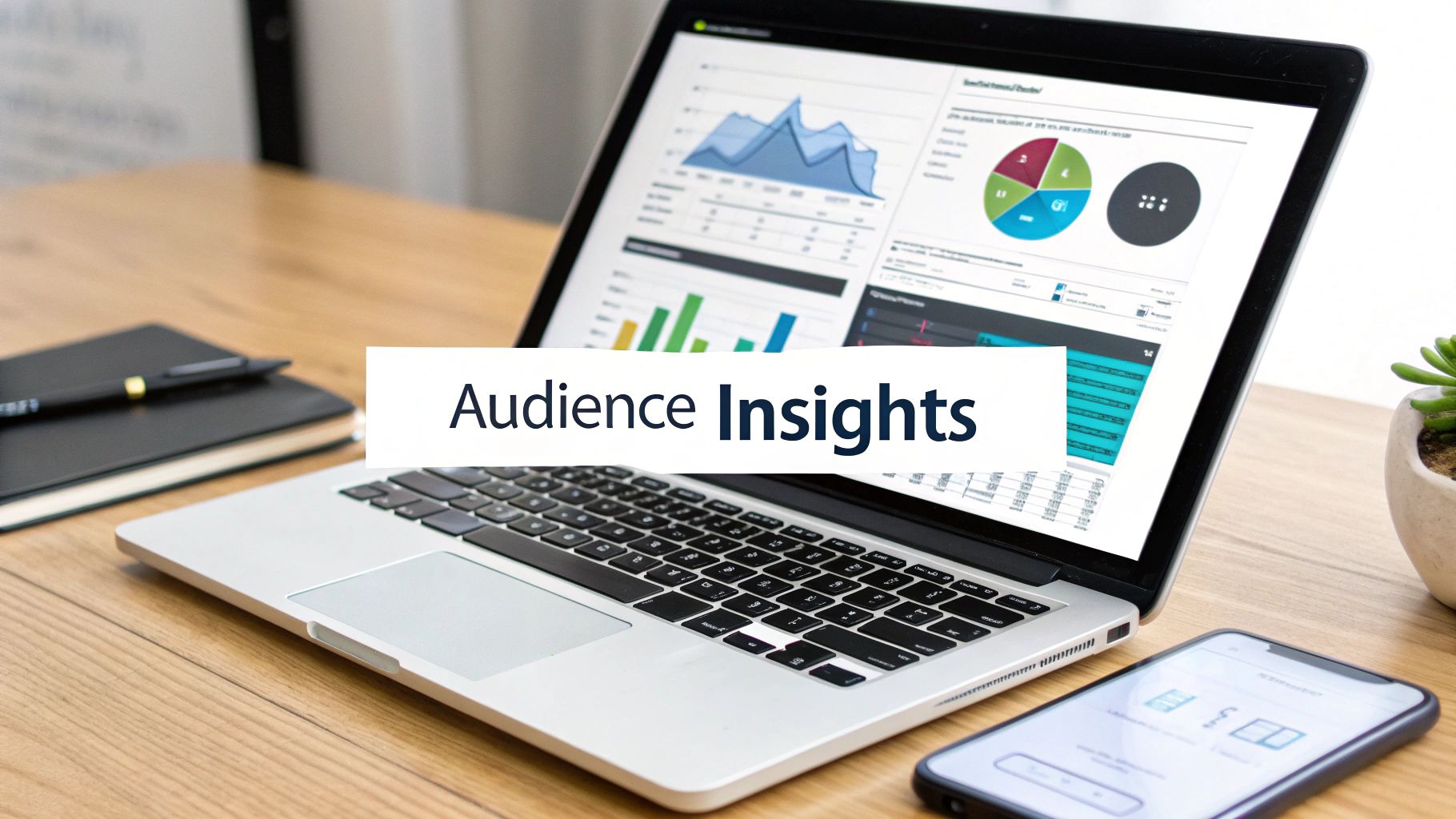
This method empowers you to schedule content with precision, ensuring your posts land at the top of feeds when your audience is ready to engage. By analyzing your follower activity, you can identify personalized peak hours that may differ significantly from industry averages, giving you a competitive edge. This personalized data can also reveal insights that help you get more likes on Instagram by aligning content with user habits.
How to Implement This Strategy
To access this data, you need a Business or Creator account. Navigate to your profile, tap "Professional Dashboard," and go to "Total Followers." Here, you'll find a detailed breakdown of your most active times by day and hour.
- B2C Brands: A beauty brand like Glossier uses its analytics to see that its core audience of 18-34 year-old women is most active between 7 PM and 9 PM EST. They schedule their evening skincare routine tutorials and product showcases during this window to maximize views and interaction.
- B2B Companies: A digital marketing agency might discover through its insights that its audience of business owners is most active on weekday mornings around 8 AM, as they check social media before starting their workday. They can then post industry news and case studies during this time.
- Personal Brands: Entrepreneur Gary Vaynerchuk analyzes his global audience insights and often posts motivational content around 6 AM EST. This timing captures his international followers as they start their day and his U.S. audience as they wake up.
Actionable Tips for Success
Consistently analyzing your data is crucial for adapting to your audience’s evolving habits.
- Check Weekly: Make it a habit to review your Instagram Insights every week. This helps you spot new patterns or shifts in follower activity before they impact your engagement rates.
- Compare and Contrast: Use general best practices (like the 11 AM – 1 PM window) as a baseline. Compare this with your account's specific data to find unique opportunities where your audience is active but competition might be lower.
- Use Advanced Tools: For deeper analysis, consider third-party platforms like Hootsuite, Sprout Social, or Later. These tools offer more detailed analytics, trend identification, and competitor benchmarking to further refine your posting schedule.
3. Post on Weekdays Rather Than Weekends
Strategic weekday posting capitalizes on higher engagement rates typically seen from Monday through Friday. This pattern emerges because users maintain consistent social media habits during their work routines, checking Instagram during commutes, lunch breaks, and downtime. In contrast, weekends often involve offline activities and more irregular social media consumption, leading to potentially lower or less predictable engagement.
Focusing your core content on weekdays helps you reach your audience when they are most mentally "plugged in" and receptive to brand messaging. Aligning your schedule with these established behavioral patterns is a powerful way to determine the best time to post on Instagram for consistent growth and interaction.
How to Implement This Strategy
To succeed with a weekday-first approach, align your content with the professional and routine-oriented mindset of your audience during this period. Your goal is to become a welcome part of their daily scroll. For a deeper analysis, you can learn more about the best days to post on social media on evergreenfeed.com.
- B2B Brands: According to HubSpot's social media research, B2B companies can see up to 32% more engagement on posts published on a Wednesday. This is when decision-makers are deep into their work week and actively seeking industry solutions.
- Creative Professionals: A brand like Adobe often posts its creative tutorials and tips between Tuesday and Thursday. This content receives significantly more saves than similar educational content posted on weekends, when users are less focused on professional development.
- Fitness Influencers: An influencer like Kayla Itsines often posts workout routines Monday through Thursday, achieving up to 45% higher engagement compared to her weekend posts. This timing aligns with her audience's motivation to stick to their fitness plans during the week.
Actionable Tips for Success
Use the weekday focus as a foundation, but remain flexible and data-driven to perfect your schedule.
- Plan Thematic Days: Structure your content around weekday themes to build anticipation and habit. For example, use "Motivation Monday" for inspirational quotes, "Tutorial Tuesday" for educational carousels, or "Feature Friday" to highlight user-generated content.
- Use Weekends Strategically: If your primary content performs best on weekdays, reserve weekends for more casual, behind-the-scenes Stories or Q&A sessions. This maintains a connection with your audience without wasting high-effort posts on lower-engagement days.
- Analyze Audience Demographics: While the weekday pattern holds true for many, younger audiences or those in entertainment-focused niches may be more active on weekends. Always cross-reference this strategy with your specific Instagram Insights.
4. Consider Time Zones for Global Audiences
If your followers are spread across different countries and continents, simply posting during your local peak hours won't be effective. For accounts with an international reach, strategic time zone consideration is crucial. This involves analyzing your audience demographics to identify key geographic concentrations and scheduling posts when the largest segments are awake and active, even if it means posting at an unconventional local time.
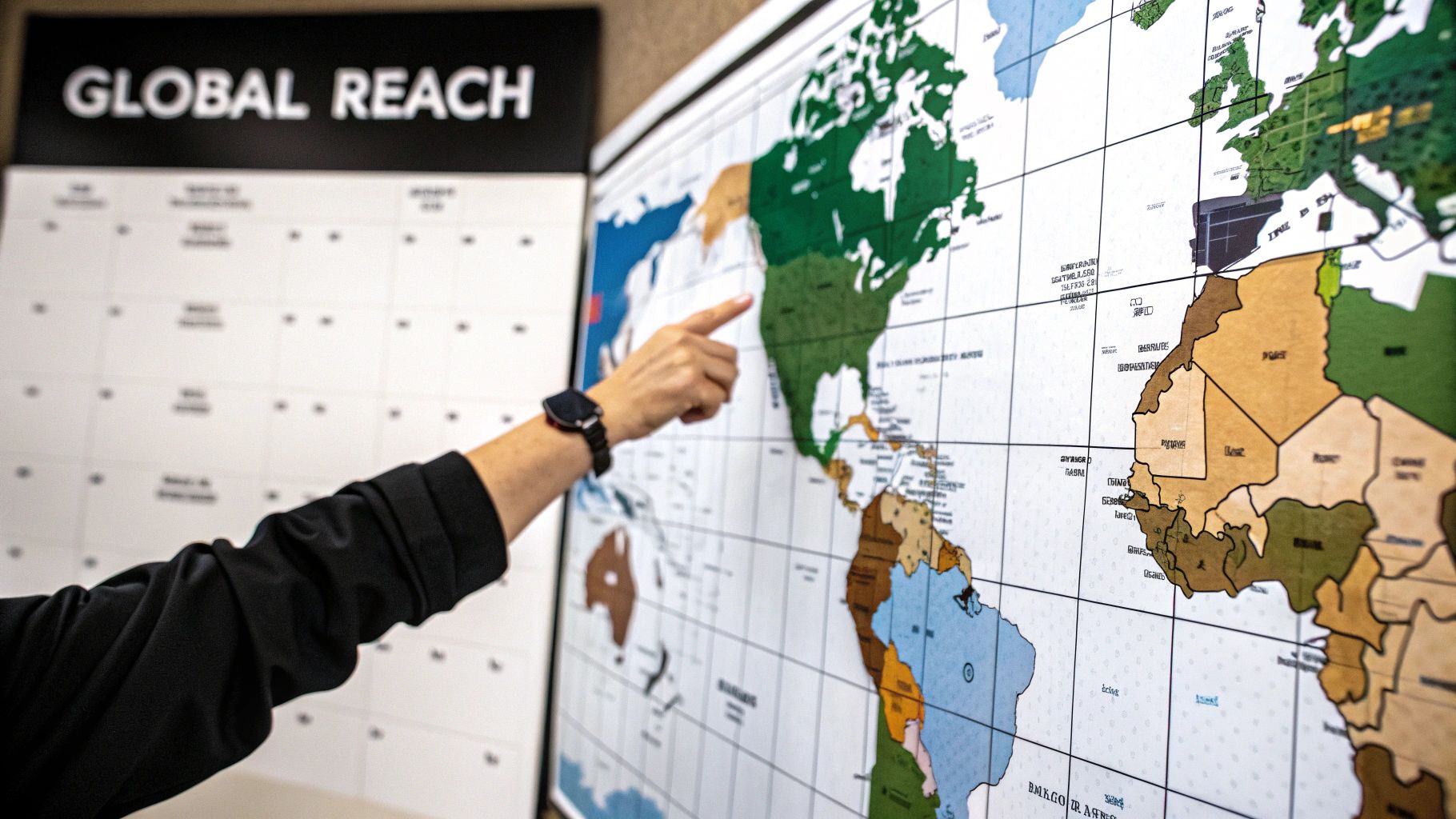
This approach ensures your content reaches its maximum potential audience, rather than being buried in the feeds of followers who were asleep when you posted. Recognizing that the best time to post on Instagram is relative to your audience's location is a key step in developing a sophisticated global content strategy.
How to Implement This Strategy
The goal is to find the sweet spot that covers the most ground. Instead of focusing on your own 9-to-5, you'll need to think about your followers' daily routines across the globe.
- Global Media Brands: A brand like National Geographic might post around 2:00 PM EST. This single post effectively captures the American lunch hour while simultaneously reaching European audiences during their evening scroll time.
- Fast-Fashion Retailers: Fashion Nova posts multiple times daily to cover different major markets. A post at 12:00 PM PST hits the West Coast lunch rush, which is 3:00 PM EST for East Coast shoppers and 8:00 PM GMT for their UK customer base.
- Travel and Hospitality: Airbnb often schedules inspiring travel content for 10:00 AM EST. This time slot connects with US morning commuters planning their next getaway and European users browsing during their afternoon break.
Actionable Tips for Success
Tailoring your schedule to a global audience requires data-driven decisions and consistent testing.
- Identify Top Locations: Use Instagram Insights to find your top 3-5 cities and countries. This tells you exactly which time zones you need to prioritize in your content schedule.
- Create a Rotational Schedule: Don't just pick one time. Create a schedule that rotates optimal posting times for different primary regions. Post for your European audience one day and your North American audience the next.
- Find a "Compromise" Time: Look for a time slot that serves as a reasonable overlap for your largest audience segments. It might not be the absolute peak for any single region, but it could be the best overall time for collective engagement.
5. Test and Experiment with Your Posting Schedule
While general guidelines provide an excellent starting point, the ultimate best time to post on Instagram is unique to your specific audience. Systematic experimentation is the only way to uncover this personalized peak. This involves creating controlled tests where you vary posting times while keeping your content quality and type consistent, then meticulously measuring engagement metrics to identify concrete patterns.
This scientific approach moves beyond assumptions and industry averages, allowing you to discover your audience's true behavioral habits. A data-driven schedule ensures you aren't just posting at a "good" time but at the most effective time for your followers, maximizing reach and interaction for every piece of content you share.
How to Implement This Strategy
A successful testing strategy requires a methodical process and a clear focus. By isolating variables and tracking outcomes, you can confidently identify what works.
- Media Companies: BuzzFeed systematically tested posting times over six months and discovered their engaging quiz content performs a staggering 80% better when posted at 3 PM EST, directly challenging the standard noon slot.
- SaaS Brands: Buffer's own internal testing revealed their optimal posting time was 1 PM PST. This was a critical insight that differed from the broader 11 AM to 1 PM recommendations and allowed them to connect with their audience more effectively.
- Local Businesses: A local restaurant chain discovered through testing that their mouth-watering food photos performed best at 5 PM. This aligns with when people are planning dinner, proving far more effective than the typical lunch hour slot.
Actionable Tips for Success
To get accurate and reliable results, structure your experiments with care and precision.
- Isolate One Variable: Test one variable at a time. For instance, post at 9 AM, 12 PM, and 5 PM on three consecutive Tuesdays, keeping the content format (e.g., Carousel post) the same to ensure you are only measuring the impact of time.
- Run Extended Tests: Run each test for at least two to three weeks. This helps account for normal weekly fluctuations and provides a more reliable data set, preventing you from making decisions based on a single good or bad day.
- Document Everything: Track your results in a simple spreadsheet. Note the day, time, post type, reach, likes, comments, and saves for each test period to easily compare performance and identify winning time slots. For more details on setting this up, explore how to schedule social media posts on evergreenfeed.com.
6. Post When Your Competitors Aren't Posting
Counter-scheduling is a savvy strategy that involves posting when your direct competitors are silent. By analyzing their activity, you can identify unsaturated time slots when your content has a better chance of standing out in your shared audience's feeds. This method is built on the principle of reduced competition, allowing your posts to capture attention without getting lost in the noise of peak-hour content floods.
When major brands in your niche post simultaneously, they create a content bottleneck, making it harder for your posts to gain initial traction. By identifying and posting during your competitors' "off-hours," you give your content more room to breathe and engage followers who are still active. This approach is a key part of finding the best time to post on Instagram by carving out your own unique window.
How to Implement This Strategy
Begin by manually tracking the posting times of your top 3-5 competitors for a week. Note when they are most active and, more importantly, when they are consistently inactive. Look for patterns and gaps in their schedules that you can strategically fill.
- B2C Brands: The fast-food chain Wendy's famously mastered this by engaging with witty, off-the-cuff content during late-night hours, a time when many of its larger competitors were inactive. This allowed them to own the late-night conversation and build a unique brand voice.
- Fitness Influencers: A smaller fitness influencer might find success posting a workout Reel at 6:00 AM EST. This captures the early-rising audience before major fitness brands, which often post later in the morning, have saturated the feed.
- Local Businesses: A local restaurant could post a "late-night menu" feature at 9:00 PM. This targets users winding down at home, a time when larger, national chain competitors have often shifted their focus away from daytime promotional posts.
Actionable Tips for Success
Effectively implementing this counter-programming strategy requires careful observation and testing.
- Map Competitor Schedules: Use tools like SocialBlade or a simple spreadsheet to track when your top competitors post. Identify consistent windows of inactivity, such as mid-afternoons or late evenings.
- Cross-Reference with Your Insights: Don't post in a dead zone. Find a time when your competitors are offline but your own Instagram Insights show at least a moderate level of follower activity. The goal is low competition, not zero audience.
- Test and Compare: Run A/B tests. Post similar content during a high-competition peak hour one week and in your identified low-competition window the next. Compare the engagement rates to see which performs better for your specific account.
7. Align Posting Times with Content Type and Purpose
Strategic content-time alignment means scheduling posts when your audience is most psychologically receptive to that specific format. Instead of just focusing on general high-traffic windows, this approach considers user mindsets and daily routines, ensuring your message lands with maximum impact. This nuanced strategy is a powerful way to determine the best time to post on Instagram for different campaign goals.
The following bar chart visualizes how aligning content pillars with specific time slots can dramatically affect average engagement rates.
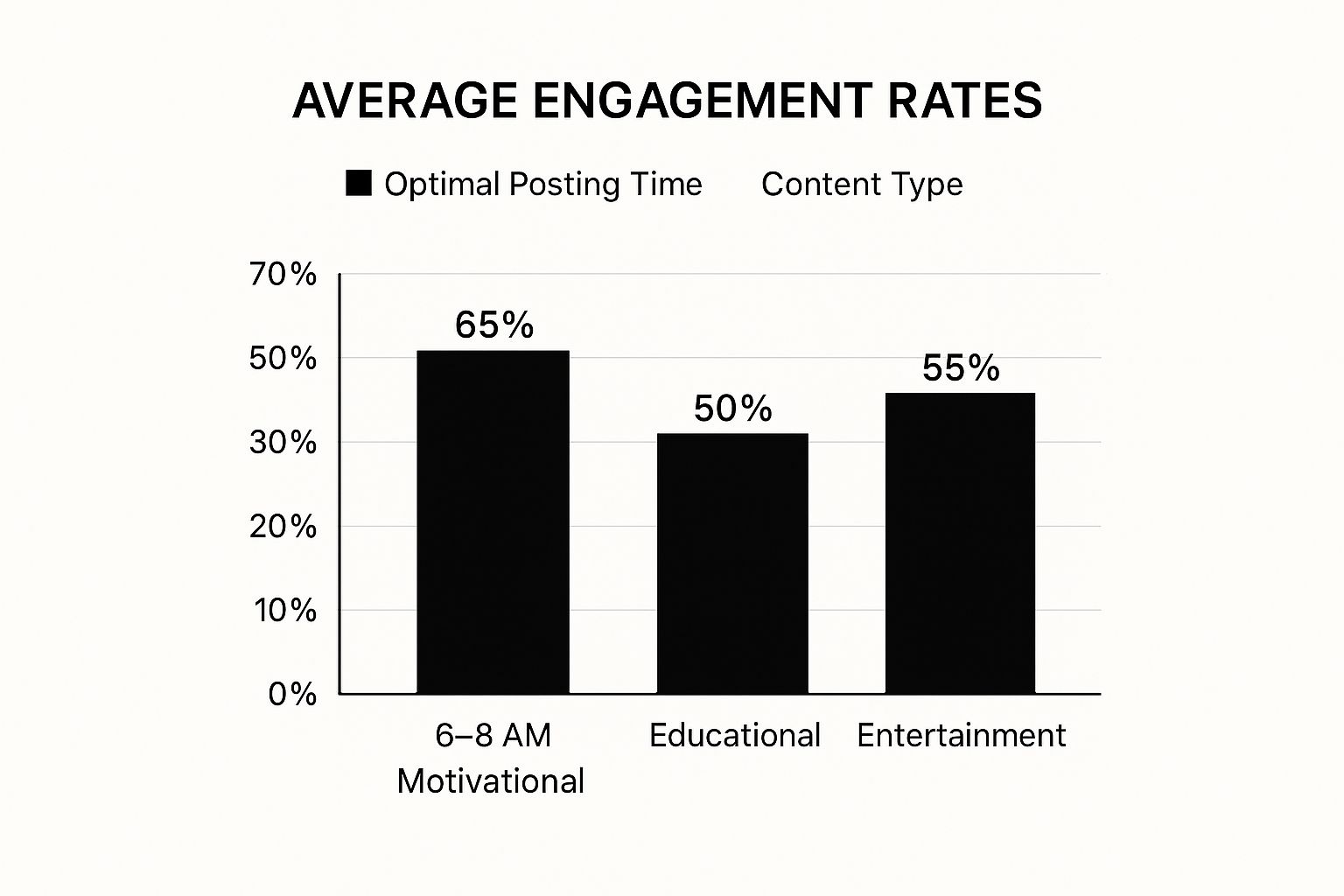
This data clearly shows that motivational content performs exceptionally well in the morning, while educational and entertainment content find their peak engagement during midday breaks and evening relaxation periods, respectively.
How to Implement This Strategy
To use this method effectively, you must first categorize your content into distinct pillars like inspirational, educational, promotional, or entertaining. Then, map these pillars to the times of day when your audience is most likely to engage with them.
- Motivational Brands: A wellness coach like Tony Robbins posts motivational quotes at 7 AM EST, catching followers as they start their day seeking inspiration. This timing can achieve significantly higher engagement than posting the same content in the afternoon.
- Food & Lifestyle Creators: Tasty, a Buzzfeed brand, often posts recipe videos around 5-6 PM EST. This targets users actively thinking about dinner plans, resulting in a higher percentage of saves as people bookmark the ideas for their evening meal.
- Educational Platforms: A brand like TED could share an insightful video clip at 12 PM EST. This timing aligns with lunch breaks when professionals are open to learning something new, leading to higher video completion rates.
Actionable Tips for Success
Tailoring your schedule to content type requires a deep understanding of your audience’s daily rhythm and psychological state.
- Map Content to Mindsets: Create a simple schedule that aligns your primary content types with your audience’s likely mindset. For example, Monday morning is for motivation, Wednesday lunchtime is for education, and Friday evening is for entertainment.
- Test Educational Slots: Post your in-depth tutorials, infographics, or carousels during common work breaks like 12 PM and 3 PM. These are moments when users are seeking a productive distraction.
- Leverage Wind-Down Hours: Share your most entertaining or relaxing content, such as Reels, memes, or user-generated content, during evening hours (7-9 PM) when users are unwinding and looking for lighthearted engagement.
- Capture Morning Motivation: Schedule your inspirational quotes, success stories, or goal-setting prompts for the early morning (6-8 AM) to connect with followers during their morning routine.
8. Schedule Posts During Commute Hours (8-9 AM and 5-7 PM)
Posting during commute hours targets a highly engaged, captive audience. The windows of 8 AM to 9 AM and 5 PM to 7 PM align with the daily travel routines of millions who use this downtime to catch up on social media. This strategy taps into moments when users are actively seeking content to fill their time on trains, buses, or as passengers, making it a crucial consideration for finding the best time to post on Instagram.
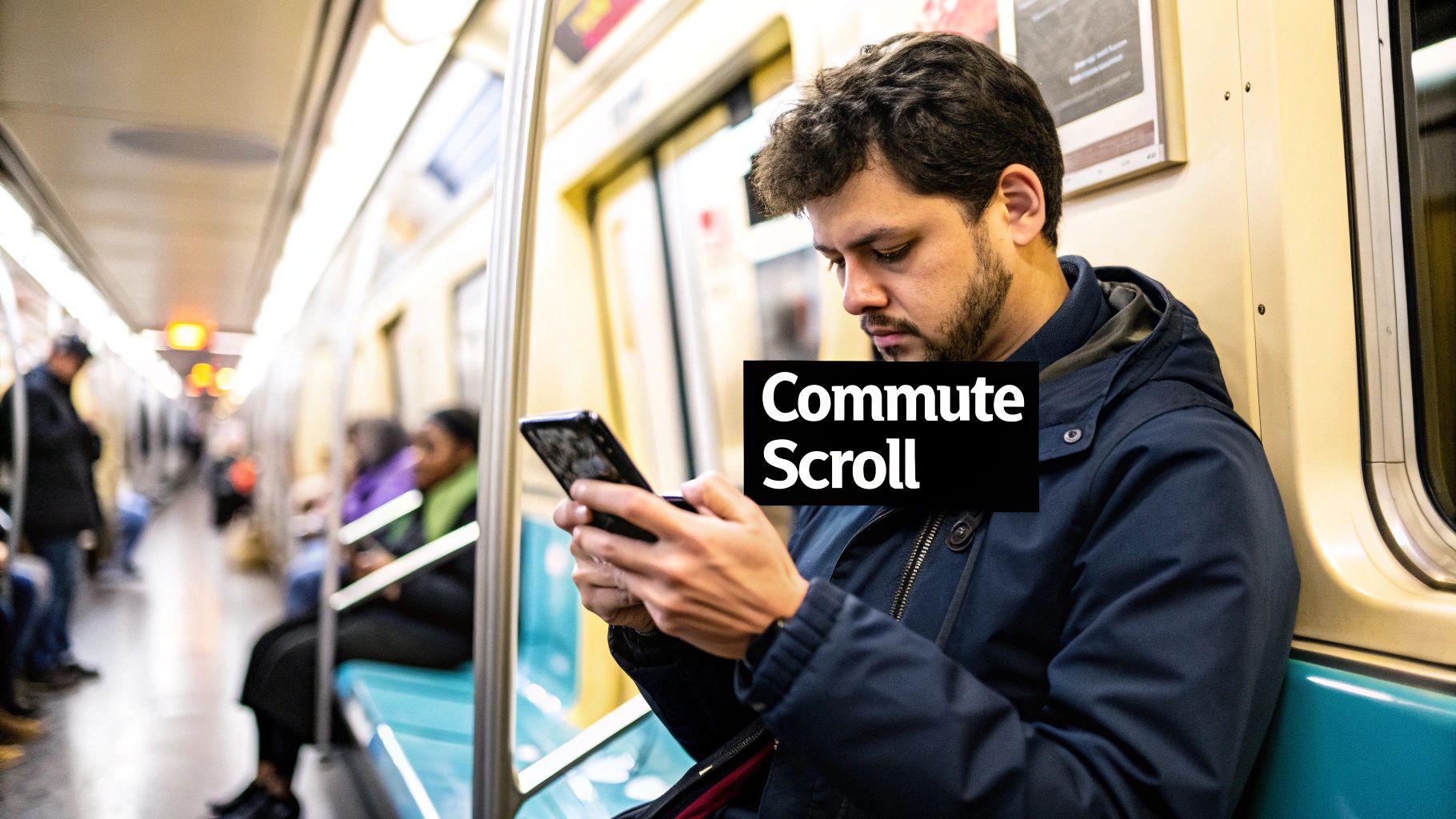
Unlike midday breaks where attention might be split, the commute offers a period of focused scrolling. Content posted during these times often sees high initial interaction rates, as users have the time to watch Stories, swipe through Carousels, and engage with posts without the immediate pressure of work or other obligations. This immediate feedback signals to the algorithm that your content is valuable, boosting its reach.
How to Implement This Strategy
Tailor your content to the specific mindset of a commuter. Morning posts can be informational or motivational, while evening content can be more entertaining or relaxing.
- Media Outlets: A publisher like The New York Times could share a morning news summary Carousel at 8:30 AM EST. This targets subway commuters with digestible headlines, often achieving significantly higher engagement than midday news updates.
- Entertainment Brands: Spotify can effectively post new playlist recommendations or podcast clips around 5:30 PM. This timing captures the attention of users looking for audio entertainment for their journey home, leading to a spike in playlist saves and follows.
- Professional Development: A platform like LinkedIn Learning might promote a short educational Reel during the morning commute. This positions professional growth as a productive way to start the day, driving higher clicks to course sign-ups.
Actionable Tips for Success
Optimizing for the commute requires a specific approach to content format and timing.
- Create "Sound-Off" Content: Design visuals, Reels, and Stories that are easily understood without audio. Use clear text overlays, captions, and strong visual storytelling, as many users will be browsing in public without headphones.
- Post Mid-Commute: Schedule your content for 15-30 minutes into the commute windows (e.g., 8:15 AM or 5:45 PM). This timing ensures your post appears when users have already settled into their journey and are actively scrolling.
- Test Both Windows: Don't assume morning and evening commutes perform equally. Use Instagram Insights to post consistently in both the 8-9 AM and 5-7 PM slots to determine which period generates better engagement from your specific audience.
Best Time to Post on Instagram: 8-Point Strategy Comparison
| Strategy | Implementation Complexity 🔄 | Resource Requirements ⚡ | Expected Outcomes 📊 | Ideal Use Cases 💡 | Key Advantages ⭐ |
|---|---|---|---|---|---|
| Post During Peak Engagement Hours (11 AM-1 PM) | Medium – scheduling at fixed times | Low – content ready for peak hours | High immediate engagement & visibility | Broad audiences active during lunch breaks | Maximum audience availability; better organic reach |
| Leverage Your Audience's Instagram Insights | High – requires analytics skills | Medium – business account & tools | Customized timing for higher engagement | Accounts wanting data-driven, audience-specific strategies | Eliminates guesswork; continuous optimization |
| Post on Weekdays Rather Than Weekends | Low – follow general schedule | Low – simple calendar planning | Consistent above-average engagement | Business, educational, professional content | More predictable audience behavior; higher shares |
| Consider Time Zones for Global Audiences | High – complex multi-region timing | High – analytics & scheduling tools | Increased global reach & engagement | Brands with international/multi-region followers | Maximizes reach across markets; builds global presence |
| Test and Experiment with Your Posting Schedule | High – requires systematic testing | Medium – time & data tracking | Discover unique optimal posting windows | Users needing personalized insights beyond general advice | Data-driven results; seasonally adaptable |
| Post When Your Competitors Aren't Posting | Medium – competitor analysis | Medium – competitor monitoring tools | Potential higher visibility in low competition windows | Brands wanting differentiation & less crowded slots | Less competition; chance to dominate niche timing |
| Align Posting Times with Content Type & Purpose | Medium – scheduling multiple times | Medium – content planning effort | Increased engagement by content relevance | Accounts tailoring posts to audience psychology and routines | Boosts engagement; predictable schedule |
| Schedule Posts During Commute Hours (8-9 AM, 5-7 PM) | Medium – timed posting | Low-medium – suitable content formats | Focused high engagement during commutes | Urban audiences with predictable commute patterns | Captures dedicated social media time; reliable timing |
Automate Your Perfect Timing and Stay Consistent
Mastering your Instagram schedule is less about finding a single "magic" hour and more about building a dynamic, data-driven strategy. We've explored the foundational principles, from leveraging peak engagement hours like the 11 AM to 1 PM weekday window to capitalizing on morning and evening commutes. Yet, the real breakthrough comes not from knowing these times, but from consistently applying them.
The most crucial takeaway is that your audience is unique. While global best practices provide an excellent starting point, your own Instagram Insights are the ultimate source of truth. The data you collect by testing different schedules, analyzing competitor quiet times, and aligning posts with specific content goals will reveal the posting patterns that resonate specifically with your followers. Finding the best time to post on Instagram is a continuous loop of testing, analyzing, and refining your approach.
From Insight to Action: The Power of Consistency
This process can feel complex, especially when managing multiple content types, catering to different time zones, or simply trying to stay on top of a busy content calendar. Manually posting at precisely 8:05 AM on a Tuesday or 6:15 PM on a Thursday is not always practical. Inconsistency is the biggest threat to a well-crafted timing strategy; if you can't execute your plan, the data becomes irrelevant.
This is where automation becomes a non-negotiable tool for serious creators and marketers. By using a scheduling platform, you transform your carefully researched schedule from a theoretical plan into a reliable, automated workflow. This ensures your content goes live at the optimal moment, every single time, without you needing to be online.
Here's how to put it all together:
- Start Small: Choose two or three strategies from this article to implement first. Perhaps you'll test posting during commute hours and analyze your own Insights for a month.
- Analyze the Impact: After a consistent period of testing, dive back into your analytics. Did engagement rates increase? Did you reach more non-followers? Use this data to refine your schedule.
- Automate for Efficiency: Once you've identified your high-performing time slots, plug them into a scheduling tool. This frees you from the tedious task of manual posting and allows you to focus your energy on what truly matters: creating valuable content that your audience loves.
Ultimately, understanding the best time to post on Instagram empowers you to stop guessing and start making strategic decisions. By combining data-backed insights with smart automation, you create a powerful system that maximizes your reach, boosts engagement, and helps you achieve your goals on the platform with unparalleled efficiency.
Ready to stop manually posting and start strategically scheduling? With EvergreenFeed, you can create content buckets, set specific schedules for each, and automatically publish your posts at the perfect times you've discovered. Try EvergreenFeed today and put your Instagram growth on autopilot.




